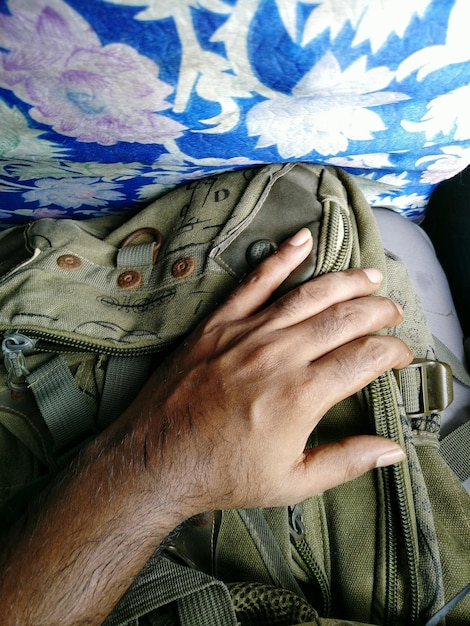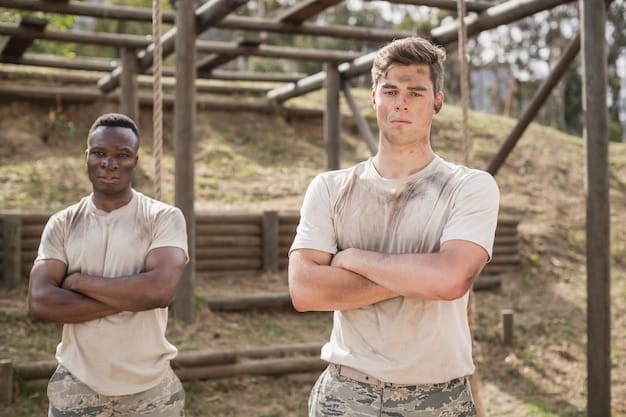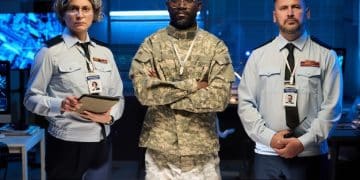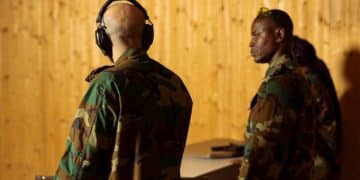Military Tattoos: Decoding Their Meaning in 2025

Military tattoos in 2025 serve as more than just body art; they represent a soldier’s personal story, their unit affiliation, and their experiences, evolving into a powerful symbol of identity and commitment within the armed forces.
The world of military tattoos is rich with tradition and symbolism, and in 2025, these meanings continue to evolve. What were once simple expressions of service have become complex narratives etched onto the skin, telling tales of camaraderie, loss, and unwavering dedication. Understanding the story behind these tattoos provides a deeper insight into the lives and experiences of the men and women in uniform.
The Enduring Tradition of Military Tattoos
Military tattoos have a long and storied history, dating back centuries. From ancient warriors marking their victories to modern soldiers displaying their unit pride, the tradition has persisted as a means of self-expression and group identity. But what do these tattoos really mean in 2025?
In the 21st century, the reasons behind getting military tattoos are as varied as the individuals who wear them. Some seek to honor fallen comrades, while others want to commemorate significant deployments or achievements. These tattoos serve as permanent reminders of their service and the bonds forged in the crucible of military life.

Historical Significance
Historically, tattoos have been a way for soldiers to identify themselves in case of death or capture. Before modern dog tags, a tattoo could provide crucial information about a soldier’s identity, blood type, and military affiliation. Today, while dog tags and digital records are the primary means of identification, the tradition of military tattoos lives on as a powerful symbol of heritage and belonging.
Modern Motivations
In 2025, the motivations for getting military tattoos are multifaceted. Here are a few key reasons:
- Commemoration: Many soldiers get tattoos to remember specific events, deployments, or comrades lost in battle. These tattoos serve as a lasting tribute to their experiences and sacrifices.
- Unit Pride: Tattoos often feature unit insignias, mottos, or symbols that represent a soldier’s affiliation and loyalty to their unit. These designs foster a sense of camaraderie and shared identity.
- Personal Expression: Military tattoos can also be a form of personal expression, allowing soldiers to showcase their individuality and tell their unique stories.
Ultimately, the enduring tradition of military tattoos reflects the deep-seated need for soldiers to connect with their history, their comrades, and themselves. By understanding the motivations behind these tattoos, we gain a greater appreciation for the sacrifices and experiences of those who serve.
Common Military Tattoo Symbols and Their Meanings
Military tattoos are replete with symbols, each carrying its own unique meaning and significance. In 2025, some symbols remain timeless classics, while others reflect contemporary military culture and experiences. Understanding these symbols is key to deciphering the stories etched onto the skin of service members.
From nautical stars to anchors to the emblems of specific military branches, the symbolism found in military tattoos is both diverse and deeply personal. These symbols often represent specific values, accomplishments, or experiences in a soldier’s career.
Nautical Star
The nautical star is a classic military tattoo symbol, particularly popular among sailors and Marines. It traditionally represents guidance and protection, with each point symbolizing a cardinal direction. For many service members, the nautical star serves as a reminder to stay on course and find their way home safely.
Anchor
The anchor is another enduring symbol in military tattoos, especially prevalent among Navy personnel. It represents stability, security, and hope. An anchor tattoo can signify a sailor’s connection to the sea, their steadfastness in the face of adversity, and their longing for safe harbor.
Branch Emblems
Tattoos featuring the emblems of specific military branches are common expressions of pride and affiliation. Each branch has its own unique symbol that represents its mission, values, and history. For example:
- Army: The U.S. Army emblem features an American bald eagle perched atop a sword and shield, symbolizing readiness and defense.
- Navy: The Navy emblem includes an anchor entwined with a rope, representing maritime strength and tradition.
- Marine Corps: The Marine Corps emblem, known as the Eagle, Globe, and Anchor, signifies the Corps’ global reach and amphibious capabilities.
These are just a few examples of the many symbols found in military tattoos. By understanding the meanings behind these symbols, we can gain a deeper appreciation for the values and experiences they represent.
The Evolving Landscape of Military Tattoo Regulations
Over the years, military tattoo regulations have evolved, reflecting changing societal norms and military standards. In 2025, the rules governing tattoos in the armed forces strike a balance between tradition and modernity, allowing for personal expression while maintaining a professional appearance.
Previously, tattoos were heavily restricted in the military, with strict guidelines on size, location, and content. However, as tattoos have become more mainstream, the regulations have become more relaxed, allowing service members more freedom in their self-expression.
Current Regulations
As of 2025, military tattoo regulations generally prohibit tattoos that are:
- Offensive or discriminatory: Tattoos that promote hate speech, discrimination, or prejudice are strictly prohibited.
- Extremist or subversive: Tattoos that advocate violence, terrorism, or the overthrow of the government are not allowed.
- Visible in certain areas: Some branches restrict tattoos on the face, neck, and hands, as these areas are considered unprofessional.
Future Trends
Looking ahead, it’s likely that military tattoo regulations will continue to evolve with societal trends. As tattoos become even more accepted and commonplace, the rules may become more relaxed, allowing for greater personal expression within reasonable boundaries.
The evolving landscape of military tattoo regulations reflects the military’s commitment to balancing tradition with modernity. By understanding these regulations, service members can make informed decisions about their tattoos while maintaining a professional and respectful appearance.

Military Tattoos as a Form of Remembrance and Mourning
For many service members, military tattoos serve as a powerful form of remembrance and mourning. These tattoos become lasting tributes to fallen comrades, allowing soldiers to carry their memories with them always. In 2025, this practice continues to be a deeply meaningful way for veterans to honor those who made the ultimate sacrifice.
The tattoos often depict names, dates, or symbols that are closely associated with the fallen. These tattoos are more than just ink; they represent a commitment to never forgetting those who served alongside them.
Memorial Tattoos
Memorial tattoos are a poignant way for soldiers to honor their fallen comrades. These tattoos often feature:
These tattoos serve as permanent reminders of the sacrifices made and the bonds forged in the heat of battle. They are testaments to the enduring spirit of camaraderie and the determination to never forget those who gave their all.
- Names and dates: The name of the fallen soldier, along with their date of birth and death, are common elements in memorial tattoos.
- Unit insignias: The unit insignia of the fallen soldier’s unit may also be included as a symbol of their shared service.
- Symbols of remembrance: Symbols such as the American flag, a cross, or a military dog tag can also be incorporated.
Military tattoos offer a unique and personal way for service members to cope with loss and honor the memory of their fallen comrades. They are a testament to the enduring bonds of military service and the unwavering commitment to never forget those who sacrificed everything.
The Psychological Impact of Military Tattoos
Beyond their symbolic and commemorative value, military tattoos can also have a significant psychological impact on service members. These tattoos can serve as a form of therapy, helping soldiers to process their experiences and find meaning in their service. In 2025, mental health professionals are increasingly recognizing the therapeutic potential of military tattoos.
For many veterans, tattoos can be a way to reclaim their bodies and their identities after experiencing trauma. The act of getting a tattoo can be empowering, allowing them to take control of their narrative and tell their story on their own terms.
Tattoos as Therapy
Tattoos can be a powerful tool for healing and recovery.
- Emotional Release: The process of getting a tattoo can be cathartic, providing an emotional outlet for soldiers to express their feelings and experiences.
- Sense of Control: Tattoos can help veterans regain a sense of control over their bodies and their narratives after experiencing trauma.
- Identity Formation: Military tattoos can play a crucial role in helping veterans reintegrate into civilian life by providing a sense of identity and belonging.
By understanding the psychological impact of military tattoos, we can better support the mental health and well-being of our service members and veterans. These tattoos are more than just ink; they are powerful symbols of resilience, healing, and hope.
The Future of Military Tattoo Art and Technology
As technology continues to advance, the world of military tattoo art is evolving at a rapid pace. In 2025, we’re seeing the emergence of new techniques, materials, and technologies that are transforming the way military tattoos are created and perceived. The possibilities for self-expression and commemoration are becoming increasingly limitless.
From advanced inks that change color based on body temperature to augmented reality tattoos that come to life with animation, the future of military tattoo art is full of exciting possibilities. These innovations are pushing the boundaries of what’s possible and creating new ways for service members to express themselves.
Technological Innovations
Here are a few key trends shaping the future of military tattoo art:
- Augmented Reality Tattoos: These interactive tattoos come to life when viewed through a smartphone or tablet, allowing soldiers to share stories, memories, and messages with others.
- Biometric Tattoos: These advanced tattoos can monitor vital signs and transmit data to medical personnel, providing real-time health information in the field.
- Personalized Designs: With the help of computer-aided design (CAD) software, tattoo artists can create highly personalized and intricate designs that reflect a soldier’s unique experiences and values.
The future of military tattoo art is bright, with technology playing a crucial role in unlocking new possibilities for self-expression, commemoration, and even medical monitoring. As these technologies continue to evolve, we can expect to see even more innovative and impactful military tattoos in the years to come.
| Key Point | Brief Description |
|---|---|
| ⚓ Tradition and Identity | Military tattoos symbolize tradition, unit affiliation, and personal stories, reinforcing a soldier’s identity. |
| 🎖️ Symbols and Meanings | Common tattoos include nautical stars, anchors, and branch emblems, each holding unique significance. |
| 📜 Evolving Regulations | Tattoo regulations balance self-expression with military standards, prohibiting offensive or extremist content. |
| 🧠 Psychological Impact | Tattoos can aid in emotional processing, providing a sense of control and identity, thereby supporting mental health. |
Frequently Asked Questions
▼
In 2025, military tattoos serve as powerful symbols of personal identity, unit affiliation, and shared experiences, reflecting a soldier’s unique narrative within the armed forces and honoring their commitment.
▼
Common symbols include nautical stars (guidance), anchors (stability), and branch emblems (affiliation). These symbols are meant to represent the values, experiences, and accomplishments integral to military service.
▼
Military tattoo regulations have evolved to balance personal expression with military standards, moving from strict limitations to a more relaxed approach that prohibits offensive or extremist tattoos to maintain professionalism.
▼
Military tattoos serve as lasting tributes by memorializing fallen comrades with names, dates, and unit insignias. This honors sacrifices and helps veterans maintain connections to those they served with.
▼
Military tattoos can positively impact service members by providing emotional release, reclaiming control after trauma, and aiding in forming a sense of identity and belonging. They facilitate emotional processing and recovery.
Conclusion
As we look to 2025, military tattoos continue to evolve as a powerful form of self-expression, commemoration, and identity. From the enduring symbols of tradition to the cutting-edge technologies of the future, these tattoos tell profound stories of service, sacrifice, and camaraderie. Understanding the meanings behind military tattoos provides a deeper appreciation for the experiences and values of the men and women who serve our country.





